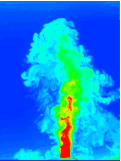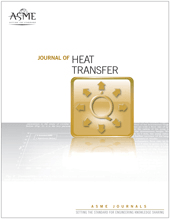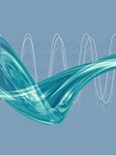
JOURNAL OF TURBULENCE
Scope & Guideline
Elevating Understanding of Fluid Mechanics
Introduction
Aims and Scopes
- Turbulent Flow Dynamics:
Research on the fundamental characteristics and behaviors of turbulent flows, including the study of velocity fields, energy dissipation, and the influence of various parameters such as Reynolds number. - Modeling and Simulations:
Development and evaluation of turbulence models, including large-eddy simulations (LES), Reynolds-averaged Navier-Stokes (RANS), and hybrid approaches to accurately predict turbulent flow behavior under diverse conditions. - Boundary Layer Studies:
Exploration of turbulent boundary layers, particularly focusing on non-equilibrium conditions, roughness effects, and pressure gradients, which are crucial for understanding flow interactions with surfaces. - Stratified and Multi-Phase Flows:
Investigation of turbulence in stratified fluids and multi-phase systems, addressing the complexities of mixing and transport phenomena in such environments. - Experimental Techniques:
Application of advanced experimental methodologies, such as particle image velocimetry (PIV) and laser-induced fluorescence, to study turbulence and validate numerical models.
Trending and Emerging
- High Reynolds Number Turbulence:
Increased focus on high Reynolds number flows, particularly non-equilibrium conditions, which are critical in aerospace and engineering applications, as evidenced by numerous studies addressing these scenarios. - Advanced Computational Techniques:
Emergence of innovative computational methods, such as deep learning and reduced-order modeling, which are being applied to turbulence modeling and simulation to improve efficiency and accuracy. - Turbulence in Stratified Flows:
Growing interest in the dynamics of stratified turbulent flows, including interactions with buoyancy and multi-phase systems, which are essential for environmental and industrial applications. - Non-equilibrium Boundary Layer Flows:
Significant research on non-equilibrium turbulent boundary layers, particularly in the context of rough surfaces and complex geometries, indicating a shift towards practical applications in engineering. - Hybrid Modeling Approaches:
Trend towards hybrid turbulence models that combine various techniques, such as LES and RANS, to enhance predictive capabilities in complex flow scenarios.
Declining or Waning
- Classical Turbulence Theory:
Research on traditional turbulence theories, such as Kolmogorov's theories of turbulence, appears to be less prominent, suggesting a shift towards more complex and application-based studies. - Simplified Models:
The use of overly simplified turbulence models that do not account for high Reynolds number effects or complex flow interactions is decreasing, as researchers favor more sophisticated and accurate modeling techniques. - Basic Experimental Studies:
There is a noticeable decline in publications focusing solely on basic experimental studies without substantial theoretical or computational frameworks, indicating a preference for integrated approaches.
Similar Journals

Journal of Mathematical Fluid Mechanics
Bridging Theory and Application in Mathematical Fluid MechanicsThe Journal of Mathematical Fluid Mechanics, published by SPRINGER BASEL AG, is a prestigious academic journal dedicated to the study of fluid dynamics through the lens of mathematics. With its ISSN 1422-6928 and E-ISSN 1422-6952, this journal has firmly established itself in the academic community since its inception in 2004, converging knowledge across various mathematical disciplines until 2024. Recognized in the top Q1 quartile rankings for Applied Mathematics, Computational Mathematics, Condensed Matter Physics, and Mathematical Physics as of 2023, it reflects a strong commitment to high-quality research and innovation. The journal features a variety of research articles, reviews, and theoretical frameworks, serving as an essential resource for researchers, professionals, and students eager to explore the mathematical principles underlying fluid mechanics. While it does not offer open access, the impact of its contributions resonates within interdisciplinary fields, advancing both theoretical insights and practical applications.

Case Studies in Thermal Engineering
Fostering Global Collaboration in Thermal EngineeringCase Studies in Thermal Engineering, published by ELSEVIER, stands as a premier platform for innovative research and analysis in the field of thermal engineering since its inception in 2013. With a robust Open Access model, this journal ensures that groundbreaking findings in fluid flow and transfer processes are readily accessible to a global audience, fostering collaboration and knowledge sharing across disciplines. Situated in the United Kingdom, the journal boasts an impressive impact factor, reflecting its status in the first quartile (Q1) for both engineering (miscellaneous) and fluid flow and transfer processes, as noted in the latest Scopus rankings. Researchers and professionals alike recognize its significance, ranking 9th out of 96 in Chemical Engineering and achieving a notable 91st percentile in its category. By publishing high-quality case studies, the journal aims to advance understanding and applications of thermal engineering principles, making it an essential resource for those looking to stay at the forefront of this dynamic field.

JOURNAL OF HEAT TRANSFER-TRANSACTIONS OF THE ASME
Pioneering Research in Thermal Dynamics.JOURNAL OF HEAT TRANSFER-TRANSACTIONS OF THE ASME, with ISSN 0022-1481 and E-ISSN 1528-8943, is a leading publication in the field of heat transfer, mechanical engineering, and related disciplines, published by the renowned American Society of Mechanical Engineers (ASME). This esteemed journal, which has been in circulation since 1945, provides a platform for novel research findings and reviews that the mechanical engineering community can rely upon, contributing significantly to the advancement of knowledge in heat transfer processes. The journal is recognized for maintaining a strong impact in several categories, attaining Q2 quartile rankings in Condensed Matter Physics, Mechanical Engineering, and Mechanics of Materials, reflecting its influential role in shaping scientific dialogues. With a commendable Scopus ranking, including a percentile of 63rd in Mechanical Engineering, it attracts submissions from leading researchers and industry professionals alike. Although access options are currently undergoing changes, the commitment to disseminating cutting-edge research remains steadfast. Gathering insights from historical and contemporary studies, the JOURNAL OF HEAT TRANSFER stands as a vital resource for those aiming to innovate in heat transfer technologies and methodologies.

FLOW TURBULENCE AND COMBUSTION
Transforming understanding in chemical engineering and physics.Flow Turbulence and Combustion is a premier peer-reviewed journal published by Springer, focusing on the intricate dynamics of fluid mechanics, turbulence, and combustion phenomena. With an impressive impact factor and categorized in the Q1 quartile across Chemical Engineering, Physical and Theoretical Chemistry, and Physics and Astronomy, this journal serves as an invaluable resource for researchers, professionals, and students engaged in these fields. Founded in 1996, it presents cutting-edge research, comprehensive reviews, and innovative methodologies that advance the understanding of turbulent flow and combustion processes. The journal's commitment to open access ensures broad dissemination of knowledge, fostering greater collaboration and advancement in scientific inquiry. Based in the Netherlands, Flow Turbulence and Combustion continues to serve as a crucial platform for reporting significant findings and developments until 2024, appealing to a global audience passionate about fluid dynamics.

Advances in Aerodynamics
Advancing Knowledge in Aerodynamic Research.Advances in Aerodynamics is a premier scholarly journal published by SPRINGERNATURE, dedicated to the innovative fields of Aerospace Engineering, Civil and Structural Engineering, Mechanical Engineering, and various aspects of Modeling and Simulation. Since its inception in 2019, this open-access journal has rapidly gained recognition, achieving a commendable Q1 ranking in several engineering categories as of 2023. With its compelling focus on pioneering research and advancements in aerodynamics, it serves as an essential platform for original research articles, reviews, and technical notes that address both theoretical frameworks and real-world applications in sustainable engineering practices. With an impact factor fostering its prominence and visibility in the academic community, the journal provides accessible content that fosters knowledge dissemination among researchers, industry professionals, and students alike. Situated in Singapore and with a commitment to rigorously peer-reviewed research, Advances in Aerodynamics is positioned to play a pivotal role in shaping the future of aerodynamics and its applications across various engineering disciplines.

Special Topics & Reviews in Porous Media-An International Journal
Navigating the Frontiers of Porous Media ResearchSpecial Topics & Reviews in Porous Media-An International Journal is a prominent academic journal published by BEGELL HOUSE INC, dedicated to the exploration and innovation within the field of porous media. With an ISSN of 2151-4798 and E-ISSN 2151-562X, this journal serves as a key platform for researchers, professionals, and students engaging with topics in engineering and materials science, holding a respectable Q3 ranking in both categories as of 2023. Spanning a publication history from 2010 to 2024, the journal aims to disseminate high-quality, peer-reviewed research that addresses the complexities and advancements in porous materials, facilitating knowledge sharing and fostering collaboration. Although not an open-access journal, it ensures broad accessibility to its valuable content through institutional subscriptions. Positioned at the intersection of theory and practical applications, Special Topics & Reviews in Porous Media plays a crucial role in advancing the understanding of this interdisciplinary field and acts as a significant resource for academics and industry practitioners alike.

Annual Review of Fluid Mechanics
Advancing the Frontiers of Fluid DynamicsThe Annual Review of Fluid Mechanics, published by Annual Reviews, is a premier journal in the field of fluid mechanics, dedicated to advancing our understanding of fluid behavior through comprehensive and critical reviews of contemporary research. With an impressive impact factor that reflects its stature—ranking Q1 in Condensed Matter Physics and positioned 4th out of 434 in Scopus’s Physics and Astronomy category—it stands as a vital resource for researchers, professionals, and students alike. Since its inception in 1970, the journal has provided vital insights and synthesized knowledge that drive innovations and applications across various scientific disciplines. Although it does not offer open access, the journal ensures rigorous editorial standards and captivating content that contributes meaningfully to the academic discourse in fluid dynamics. Published annually, the Annual Review of Fluid Mechanics continues to be a cornerstone for anyone interested in the complexities of fluid movement and its implications in both theoretical and practical contexts.

IZVESTIYA ATMOSPHERIC AND OCEANIC PHYSICS
Fostering collaboration for groundbreaking environmental insights.Izvestiya Atmospheric and Oceanic Physics is a distinguished journal dedicated to advancing the fields of atmospheric science and oceanography, published by MAIK Nauka/Interperiodica/Springer. With a rich publication history spanning from 1972 to the present, this journal serves as a vital platform for both theoretical and experimental studies that enhance our understanding of complex atmospheric and oceanic systems. Despite its current categorization in the Q4 quartile according to the 2023 rankings, the journal continues to provide crucial insights, as evidenced by its established ranks in Scopus—placing it in the 15th and 26th percentiles of its respective categories. Researchers, professionals, and students alike are encouraged to contribute to and engage with the latest findings published in this journal, fostering a collaborative spirit within the scientific community dedicated to tackling pressing environmental challenges.

JOURNAL OF ENHANCED HEAT TRANSFER
Empowering Researchers to Shape the Future of Thermal EfficiencyThe JOURNAL OF ENHANCED HEAT TRANSFER, published by BEGELL HOUSE INC, is a prominent resource for researchers and professionals in the fields of mechanical engineering, fluid flow and transfer processes, and condensed matter physics. With a history spanning from 1993 to 2024, this journal offers a platform for disseminating cutting-edge research and innovations that enhance our understanding of heat transfer phenomena. Although it operates under a traditional subscription model, its impressive standing is underscored by its Scopus rankings—positioned within the 59th percentile for Mechanical Engineering and 58th percentile for Fluid Flow and Transfer Processes. Additionally, it holds Q2 and Q3 categorizations in relevant fields, reflecting its importance in advancing knowledge and applications in heat transfer technology. This journal effectively bridges the gap between theoretical insights and practical solutions, making it an indispensable tool for academics, industrial practitioners, and students eager to explore advancements in thermal management and efficiency.

BOUNDARY-LAYER METEOROLOGY
Pioneering Research in Boundary-Layer MeteorologyBOUNDARY-LAYER METEOROLOGY is a prestigious journal dedicated to advancing the understanding of atmospheric boundary layers and their interactions with the Earth's surface. Published by SPRINGER, this esteemed journal has established itself as a leader in the field, boasting a Q1 ranking in Atmospheric Science for 2023. With an ISSN of 0006-8314 and an E-ISSN of 1573-1472, BOUNDARY-LAYER METEOROLOGY has been an invaluable resource for researchers and academics since its inception in 1970. As of 2024, the journal continues to publish cutting-edge research, contributing to its strong Scopus ranking of #28 out of 148 in Earth and Planetary Sciences and an 81st percentile standing. While the journal does not currently offer open access options, its high impact factor ensures that published work reaches a wide academic audience. The journal is essential for professionals and students alike, facilitating knowledge exchange and inspiring future research in the dynamic field of boundary-layer meteorology.